Nepal
Things to DO
Royal Chitwan National Park
In the early part of this century, the Chitwan was a centre for the hunting exploits on which British royalty was so keen.
King George V and his son the Prince of Wales, later Edward VIII never made it to Kathmandu but they did slaughter wildlife
in the Chitwan forest. In 11 fun-packed days during one hunting safari in 1911, they killed 39 tigers and 18 rhinos.
The park actually became a national sanctuary in 1973 and since that timethe animal population has rebounded.
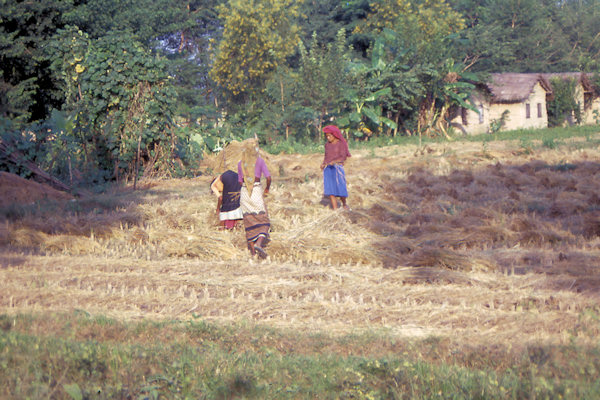 |
|||||
Sauraha
Sauraha is a simple, quite little village - the sort of place nobody would usually visit - so staying here is a good opportunity to observe
Nepalese rural life. There are glowing rice fields, neat and clear houses, little bams with cattle and a village well close to the
Elephant breeding centre
Elephant Breeding Center
It was estimated that at the time of King George V’s hunting safari in 1911 there were over 2.000 elephants in Nepal. By the 1970’s this
had fallen to around 200.
The center was set up in 1989 to try to increase the population of the Asian elephant in the region through breeding.
Today that number has only risen slightly with the over half of the elephants located in the Chitwan region.
Rhinoceros
The great thrill at the Chitwan is the traditional elephant-back safaris in search of wildlife; and seeing a rhino from atop an elephant
is an experience not to be missed.
Pokhara
Pokhara stands at 884 meters above sea level and the vallay has three large lakes. Two of them, Rupa Tal en Begnas Tal,
are slightly to the east of town while the third and largest Phewa Tal is the focal
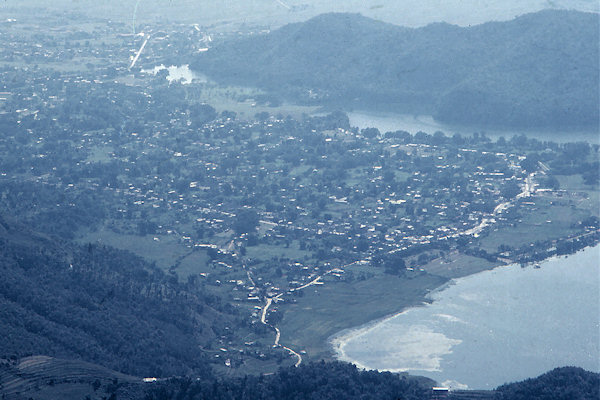 |
|||||
point of Pokhara's tourist centre.
Pokhara's development has been recent and rapid. Only with the eradication of malaria in the 1950s did it become safe to live here.
The construction of an airstrip in the '50s, the hydroelectric power dam in 1968 and the building of the roads to Kathmandu and the
Indian border in the early '70s, catapulted Pokhara into the 20th century.
Sarangkot
This very pleasant walk up to Sarangkot, at an elevation of 1.592 metres, is probably the most popular short excursion from Pokhara. It
takes about 3 or 4 hours to walk to Sarangkot from the lakeside.
Sarangkot once had a fort or "kot"and its remains can be seen on the very top of the ridge above Sarangkot. There is a lookout point
inside the old fort walls and the vieuws of the Anapurnas to the north is superb.
Kathmandu
Kathmandu is the capital of Nepal, the largest city in the country and the main centre for hotels and restaurants.
It's an amazing city that, in places, can seen to be one huge, intricate sculpture unchanged since the Middle Ages. At other times it seems
to be rushing carelessly into the 20th century.
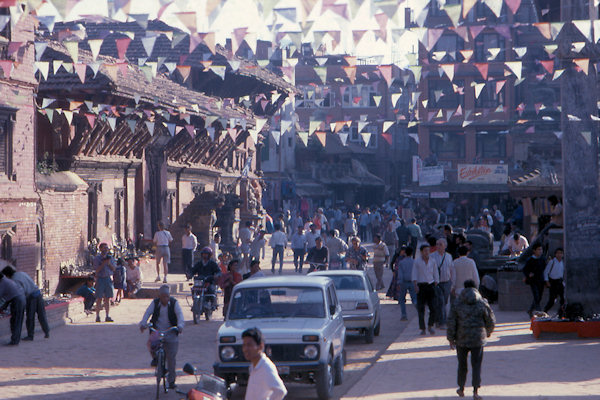 |
|||||
For many people, arrivin in Kathmandu is as shocking as stepping out of a time machine - the sights, sounds and smells can lead to
sensory overload.
There are nerrow streets and lanes with carved wooden balconies leaning over tiny shops, squares packed with extraordinary temples and
monuments, markets bright with fruit and vegetables and a constant throng of humanity. Then there's choking dust and fumes, stinking
gutters, concrete monstrosities, touts, Coca-Cola billboards and maimed beggars.
The gab between rich and poor is a chasm, but despite the pressures of extreme overcrowding and poverty, people retain a good-humoured
self respect and integrity. It is probably safer to walk the streets here than it is in yor home town - and certainly much moere interesting.
Rani Pokhari
It was built by King Pratap Malla in 1667 to console his queen over the death of their son.
A causeways leads across the tank to a small Shiva Temple.
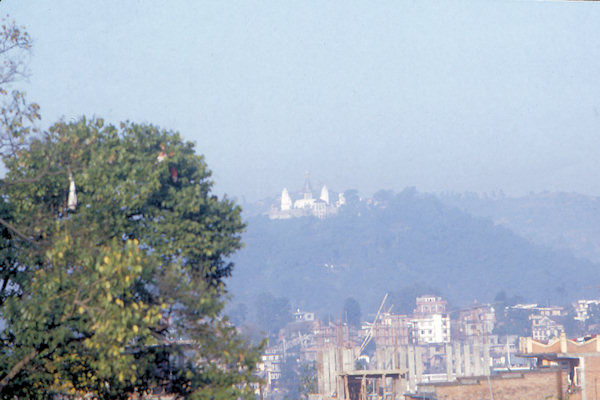 |
|||||
Swayambhunath
The Buddhist temple of Swayambhunath situated on the top of a hill west of the city, is one of the most popular and instantly recognisable
symbols of Nepal.
It is said that Emperor Asoka paid a visit ti the site over 2.000 years ago. An inscription indicates that King Manadeva
ordered work done on the site in 460 AD end by the 1200s it was an important Buddhist centre.
From the flattened top of the hill, the soaring central stupa is topped by a gold-coloured square block from which the watchful eyes of
the Buddha gaze out across the valey in each direction.
The question mark-like "nose" is actualy the Nepali number ek or one and is symbol of unity. Between and above the two eyes
is a third eye, symbolising the Buddha's clairvoyant powers.
Set around the base of the central stupa is a continuous series of prayer wheels which pilgrims, circumambulating the stupa, spin as they
pass by.
Patan
Patan is separated from Katmandu only by the Bagmati River and is the second largest town in the valley.
Patan has a long Buddhist history and the four corners of the city are marked by stupas said to have been erected by the great Buddhist
emperor Ashoka himself around 250 BC.
Later inscriptions refer to palaces in the city in the 5th century AD although Patan's great building boom took place under the Mallas in
the 16th, 17th and 18th centuries.
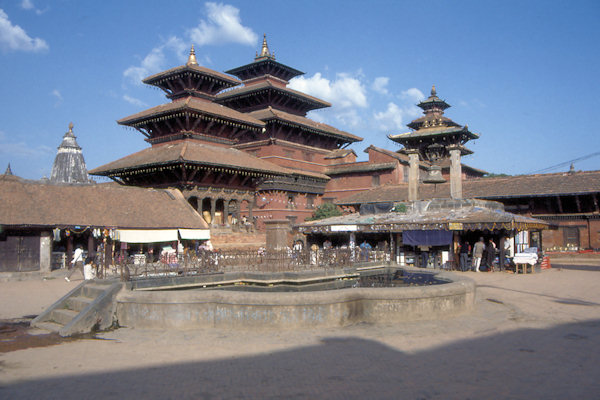 |
|||||
Durbar Square
Durbar Square is a concentrated mass of temples, undoubtedly the most visually stunning display of Newari architecture to be seen in
Nepal.
The rectangular square has its longer axis running nort-south and the palace forms the eastern side of the square whith a continuous row
of temples in widely diverse style face it on the western side.
The square rose to it's full glory during the Malla period, and particularly during the reign of King Siddhinarsingh Malla
(reign 1620-1661).
Royal Palace
Parts of the palace were built in the 14th century, but the main period of construction was during the 17th and 18th centuries.
It was severely damaged during the conquest of the valley by Prithvi Narayan Shah in 1768 and also by the great earthquake in 1934,
but it remains one of the architectural highlights of the valley with a series of three connecting courtyards or Chowks.
The Sundari Chowk holds a sunken tank known as the Tusha Hiti.
It is decorated with several religious and symbolic stone carvings and bronze sculptures: Images of Hanuman the monkey god and
Krishna grace each side, there are eight each of incarnations of Vishnu, Indian Naga Kings and Mother Goddess
figures, and the tap is carved in the shape of a conch shell, supporting a small statue of Lakshmi.
The tank was originally built in 1670 and restored in 1960.
The Mani Keshar Chowk is the newest part of the palace, its construction was completed in 1734.
Krishna Mandir
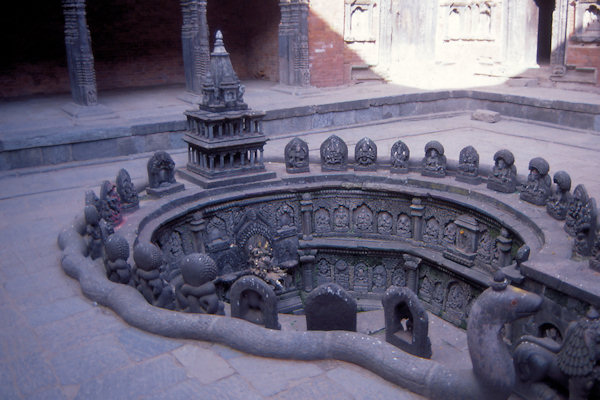 |
|||||
With its strong Moghul influences this stone temple is clearly of Indian design, unlike the nearby brick and timber, multiroofed
Nepalese temples. The 1st and 2nd floors are made up of a line of pavilions from the top of which rises a corncob-like shikhara.
Krishna is an incarnation of Vishnu so the god's vehicle, the man-bird Garuda, kneels with folded arms on top of a column.
Kumbeshwar Temple
This five-storey temple dominates the streets around it and is said to date from 1392, when it was completed by Jayasthiti Malla
(reign 1380-1395), making it the oldest extant temple in Patan.
The temple is noted for its fine propotions and elegant woodcarvings and there are numerous statues and sculptures around the courtyard.
Ashokan Stupas
The Northern Stupa is just beyond the Kumbeshwar Temple, not far from Durbar Square. It's well preserved and whitewashed.